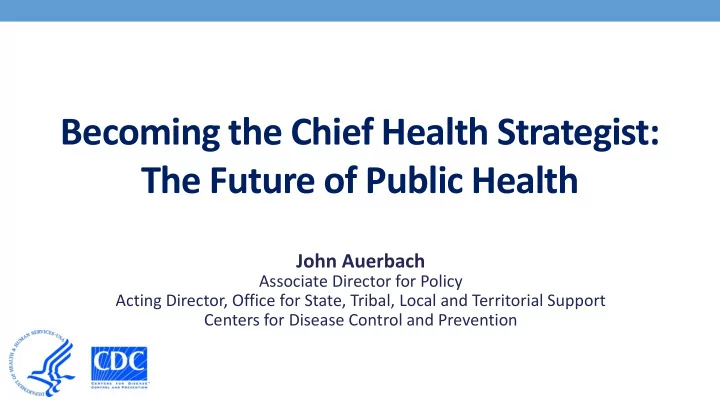

Becoming the Chief Health Strategist: The Future of Public Health John Auerbach Associate Director for Policy Acting Director, Office for State, Tribal, Local and Territorial Support Centers for Disease Control and Prevention
CDC Strategic Directions Improve Better prevent health security the leading at home and causes of illness, around the injury, disability, world and death Strengthen public health/ healthcare collaboration
National Trend #1: Increased Access 20 million Americans have gained insurance for the first time Meaning for Public Health Decreased need for public health safety net programs and services SOURCE: JAMA. 2014;314(4):328. doi:10.1001/jama.2015.8129; http://kff.org/other/state-indicator/total-population/; Behavioral Risk Factor Surveillance System, 2013 & Preliminary 2014; National Health Interview Survey
National Trend #2: Payment Reform Is Widespread Shift from “Volume - Based” Payment Model (Fee-for-Service) to “Value - Based” Payment Model Meaning for Public Health Possibility of paying for more preventive services
National Trend #3: Emerging Clinical Care Models 50 million patients are currently being served by federally qualified health centers and accountable care organizations Meaning for Public Health Increased opportunities to link clinical care and communities
National Trend #4: Other Conditions Demand an Overhaul Demographic characteristics and healthcare needs of the US population are changing Meaning for Public Health Alignment of public health policies and services to address these changing needs
National Trend #5: Public Health Evolution Public health funding has been declining since 2008 Meaning for Public Health Evaluation of core public health functions
Public Health as Chief Health Strategist • Less direct care — more policy • Programs tailored to emerging needs & populations • Convening coalitions • Partnering with healthcare and diverse sectors • Upstream focus • Real-time and new data
Key Practices of the Chief Health Strategists of the Future Population Growth Over the Age of 65 Practice #1: Adopt and adapt strategies to combat the evolving leading causes of illness, injury, and premature death US Census Bureau, December 2012
Key Practices of the Chief Health Strategists of the Future Practice #2: Develop strategies for promoting health and well-being that work most effectively for communities of today and tomorrow Community-Wide Traditional Clinical Innovative Clinical Prevention Prevention Prevention The 3 Buckets of 3 1 2 Prevention Implement Provide services Increase the use interventions that that extend care of clinical reach whole outside the clinical preventive populations setting services Health Care Public Health
Key Practices of the Chief Health Strategists of the Future Practice #3: Identify, analyze, and distribute information from new, big, and real-time data sources DASH is a national Robert Wood Johnson Foundation program
Key Practices of the Chief Health Strategists of the Future • Practice #4: Build a more integrated, effective health system through collaboration between clinical care and public health conditions | 6 18 Evidence-based High-burden interventions that health can improve health and save money
10
Examples of 6|18 Interventions Bucket 1 Examples: Bucket 2 Examples: In Clinical Settings Outside of Clinical Settings Improve access to medications (e.g., Self-measured home blood pressure via elimination of cost sharing) monitoring Expand access to comprehensive Diabetes Prevention Program tobacco cessation treatment Remove barriers to use of long-acting Home visits for asthma care (to reduce reversible contraceptives home triggers)
Key Practices of the Chief Health Strategists of the Future • Practice #5: Collaborate with a broad array of allies — including those at the neighborhood-level and the non-health sectors — to build healthier and more vital communities
Addressing the Social Determinants of Health Community-Wide Health Improvement Initiatives
Coming Soon! Population Health Initiative A core set of 24 evidence-based community population health interventions that aim to • Improve the health of the larger community (as contrasted with approaches that are clinical and patient-oriented) • Demonstrate health and cost impact • Address social, economic, or environmental conditions
Key Practices of the Chief Health Strategists of the Future • Practice #6: Replace outdated organizational practices with state-of-the-art business, accountability, and financing systems
Key Practices of the Chief Health Strategists of the Future • Practice #7: Work with corresponding federal partners — ideally, a federal chief health strategist — to effectively meet their communities’ needs
A Reminder About the Issues . . . Meet Fran Edwards • Newly insured • At MD for first physical in 5 years • 55 years old, married, smokes, overweight, little exercise • Asthmatic, high blood pressure • Stopped taking medications in past due to cost
Insurance and Quality Care Help . . . But the Following Also Contribute to Her Health • Income — Low-income family of 5 • Barriers to fitness — Rising crime rate, few parks, no nearby supermarket • Under stress — Child with behavioral health concerns, worried about money • Sub-par housing — Mold and ventilation problems
How Can Each Sector Help Ms. Edwards? • Payers and providers • Bucket 1: No co-pay for her medications • Bucket 2: Home visits to reduce asthma • Hospitals • Bucket 3: Invest in healthy housing options; support for community policies • Public health • Buckets 1 & 2: Participate in meetings of insurers; support for 6|18 • Bucket 3: Support for equity; health-promoting policies in lower-income communities
Centers for Disease Control and Prevention 1600 Clifton Road NE, Atlanta, GA 30333 Phone: 1-800-CDC-INFO (232-4636)/TTY: 1-888-232-6348 E-mail: cdcinfo@cdc.gov Web: www.cdc.gov
Recommend
More recommend